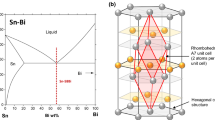Abstract
Although the performance of electronic devices in extreme temperature ranges has been extensively studied, the interconnections, which are still mainly Sn-based materials, require thorough observation and assessment to support the mechanical and electrical stability in subzero to cryogenic temperature environments. An in-depth assessment is required because of the nature of Sn, which has a ductile-to-brittle transition temperature of approximately −60°C. Sn-1Ag-0.5Cu (wt.%) (SAC105) solder joints were subjected to shear testing at room temperature and at −196°C at liquid nitrogen temperature. Isothermal aging at 150°C for 50–500 h prior to cryogenic temperature testing indicated further degradation under certain aging conditions. The study presented here investigates the maximum shear strength variations for SAC105 single solder joints with NiAu and Cu-organic solderability preservative (Cu-OSP) pad surface finishes using a multibond tester with a 10-μm shear height and 100-μm/s shear speed. An increase in the maximum shear strength was observed at liquid nitrogen temperature compared to that at room temperature due to an increase in the yield strength and loss in ductility of the solder material in response to the low-temperature environment. The maximum shear strength decreased with isothermal aging due to the crack propagation path variation. Fracture locations were identified between the Ni pad and the (Cu, Ni)6Sn5 interface for the NiAu surface finish components, and Cu-OSP surface finish solder joints revealed transgranular crack through the Cu6Sn5 and crack propagation between the Cu6Sn5 and the solder interface. The shift in the full fracture location is discussed in association with electron backscatter diffraction (EBSD) analysis on partially sheared solder joints at room temperature and at −196°C.
Similar content being viewed by others
References
T. Bayer, M. Bittner, B. Buffington, G. Dubos, E. Ferguson, I. Harris, M. Jackson, G. Lee, K. Lewis, J. Kastner, R. Morillo, R. Perez, M. Salami, J. Signorelli, O. Sindiy, B. Smith, M. Soriano, K. Kirby, and N. Laslo, in IEEE Aerospace Conference proceedings (Big Sky, MT, US 2019), pp. 1–24
Mission to Europa: Europa Clipper (JPL webpage), https://www.jpl.nasa.gov/missions/europa-clipper/. Accessed 25 August 2020.
E. Charbon, F. Sebastiano, A. Vladimirescu, H. Homulle, S. Visser, L. Song, and R.M. Incandela, in IEEE International Electron Devices Meeting (IEDM) proceedings, (San Francisco, CA, 2016) pp. 13.5.1–13.5.4.
A. Lupinacci, A. Shapiro, J. Suh, and A. Minor, in IEEE International Symposium on Advanced Packaging Materials proceedings (2013), pp. 82–88
P. Ratchev, B. Vandevelde, and B. Verlinden, IEEE Trans. Compon. Packag. Technol. 30, 416 (2007).
Q. An, C. Wang, X. Zhao, and H. Wang, in 18th International Conference on Electronic Packaging Technology proceedings (ICEPT), Harbin, China (2007), pp. 1233–1237.
K. Lambrinou, W. Maurisse, P. Limaye, B. Vandevelde, B. Verlinden, and I. Wolf, J. Electron. Mater. 38, 1881 (2009).
T.-K. Lee, B. Zhou, T. Bieler, and K.-C. Liu, J. Electron. Mater. 41, 273 (2012).
T.-K. Lee, C.-U. Kim, and T. Bieler, J. Electron. Mater. 43, 69 (2014).
T.-K. Lee, C.-U. Kim, and T. Bieler, J. Electron. Mater. 45, 171 (2016).
R. Tian, Y. Tian, C. Wang, and L. Zhao, Mat. Sci. Eng. A 684, 697 (2017).
P. Ratchev, T. Loccufier, B. Vandevelde, B. Verlinden, S. Teliszewski, D. Werkhoven, and B. Allaert, in IMAPS Eur. Microelectron. Pack. Conf. proceedings, Brugge, Belgium (2005), pp. 248–252
C. Tseng, T.-K. Lee, G. Ramakrishna, K. Liu, and J. Duh, Mater. Lett. 65, 3216 (2011).
S. Fu, C. Yu, T. Lee, K. Liu, and J. Duh, Mater. Lett. 80, 103 (2012).
F. Gao and T. Takemoto, Mater. Lett. 60, 2315 (2006).
D. Mu, H. Huang, and K. Nogita, Mater. Lett. 86, 46 (2012).
J. Xian, Z. Ma, S. Belyakov, M. Ollivier, and C. Gourlay, Acta Mater. 123, 404 (2017).
G. Zeng, S. McDonald, J. Read, Q. Gu, and K. Nogita, Acta Mater. 69, 135 (2014).
S. Wright, N. Nowell, and D. Field, Microsc. Microanal. 17, 316 (2011).
S. Jin, W. Horwood, J.W. Morris Jr, and V. Zackay, Adv. Cryog. Eng. 19, 373 (1995).
J.W. Morris Jr, C. Lee, and Z. Guo, ISIJ Int. 43, 410 (2003).
J.W. Morris Jr, Science 320, 1022 (2008).
Acknowledgments
This work is an outcome of a research collaboration project between Portland State University and Nordson Dage. The authors also want to thank Tony Chen and Greg Baty in the Center of Electron Microscopy and Nanofabrication (CEMN) at Portland State University for their technical support on EBSD imaging and analysis.
Author information
Authors and Affiliations
Corresponding author
Ethics declarations
The authors declare that they have no conflict of interest.
Additional information
Publisher's Note
Springer Nature remains neutral with regard to jurisdictional claims in published maps and institutional affiliations.
Rights and permissions
About this article
Cite this article
Kitamura, A., Matthews, T., Contreras, R. et al. Impact of Cryogenic Temperature Environment on Single Solder Joint Mechanical Shear Stability. J. Electron. Mater. 50, 723–734 (2021). https://doi.org/10.1007/s11664-020-08456-5
Received:
Accepted:
Published:
Issue Date:
DOI: https://doi.org/10.1007/s11664-020-08456-5




